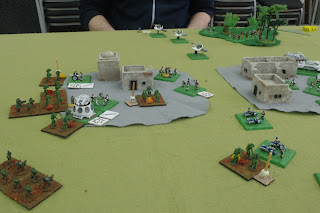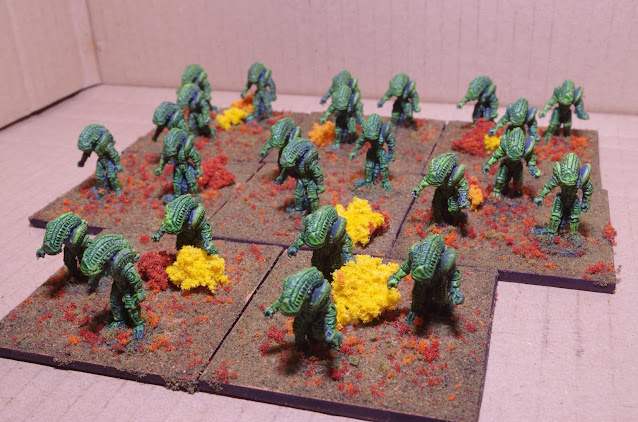I've not played Sharp Practice with my ACW forces for quite a while, so this game at the
club was a chance to get the armies out again. The figures and buildings are all
Peter Pig and the redoubts/earthworks are by
Ironclad Miniatures.
I originally planned to play against Nick, but Andy needed a game, so I umpired, which made a bit of a change. The scenario was as follows;
This
is an early war scenario where both sides are made up of conscripts
and volunteers. All infantry are equipped with rifled muskets. Following
an indecisive battle, both armies have retreated to lick their wounds and
regroup.
However, the Confederates wish to reoccupy some earthworks
from which they withdrew in the battle, because these earthworks will
allow them to place artillery to deter the Union army from advancing
along the valley which they overlook.
The
Union commander is keen to take the earthworks to prevent the Rebels
from siting guns in them.
On
the Union side, the ground contains a farm, surrounded by fencing and
a smaller farm building. The Union deployment point will be
represented by a group of tents which was used as a dressing station
in the previous battle. The Union force also has a secondary deployment point
which will be represented by a signpost. There is a small coppice of
trees in the centre of the table. The Confederates will deploy from around a small church which is behind a hill which contains one of the three redoubts. A second redoubt is on the hill opposite the farm and the third one is in the valley between the two hills.
The terrain is basically open fields with little or no cover, as can be seen below;
The two small forces were;
Union
3 groups of 8
infantry (conscripts and volunteers) with a Status 3 Leader
2 groups of 8
infantry (conscripts and volunteers) with a Status 2 Leader
2 groups of 6
skirmishers (conscripts and volunteers) with a Status 1 Leader
Additional: 1 Status
1 Leader, 1 Musician and 1 Colour Party
Confederates
3 groups of 8
infantry (conscripts and volunteers) with a Status 3 Leader
2 groups of 8
infantry (conscripts and volunteers) with a Status 2 Leader
1 group of 6
skirmishers (conscripts and volunteers) with a Status 1 Leader
1 medium cannon with
5 crew and a Status 1 Leader
Additional: 1
Musician 1 and 3 sections of earthworks
Ideally, the Union forces would have deployed from around the farm but the dice roll placed their deployment point at the same end of the table as the Confederate one.
The Confederate side deployed first, swiftly getting troops on the hill in front of the church and sending the rest of the infantry and skirmishers to occupy the other sets of earthworks.
The Union troops were slower to arrive but started to cross the open fields, with the larger group moving to take up a firing position in the trees.
This initial deployment pretty much defined the shape of the battle ahead. The two groups of Union skirmishers arrived a bit later, with some Berdan's Sharpshooters deploying first, followed by some Zouaves.
This central redoubt would come under sustained fire from the larger group of Union infantry before long, taking many casualties and finally forcing the formation to withdraw. The redoubt on the Confederate right provided cover for the skirmishers to pepper the treeline with fire, preventing the Union troops from taking advantage of the retreating Confederate infantry.
The Union skirmishers opened fire on the main objective, the redoubt on the hill in front of the church, causing shock and casualties, and wounding the commander, leaving him knocked out for a few rounds. The Confederates here could only be activated by using command cards until he came round and resumed command.
The Berdan's Sharpshooters took casualties from the hill but their accurate fire was causing problems for the Confederate side. However, the artillery finally arrived and the cannon fire proved to be pretty worrying for the Union troops in the open fields.
Disaster struck the Union side when the force commander was killed by the Confederate skirmishers. They also suffered on the random events table by becoming inflicted with the curse of wet powder, which reduced their firing dice by half.
The Union skirmishers also fared less well, as their numbers began to fall.
A roll on the random firing event table caused the church to burst into flames. It must have been a stray spark from the Confederate cannon.
The battle was developing into a stalemate. The Union troops were unable to cross the open fields without losing men to the Confederate musketry and therefore were unable to occupy the objective. The battle was clearly a victory for the Confederate force.
I think that this was an interesting game, because the terrain really didn't suit the attacking side at all, because the deployment points were out in the open. However, the superior skills of the skirmishers did keep the Confederate occupied for most of the battle.
There was a moment of light relief when the sergeant commanding the group of Berdan's Sharpshooters rolled on the movement random events table and was found to have slipped in some dog poo. We decided that he would have to return to the tents to find water to clean his boots, which took them out of the firing line for a couple of turns.
I think that I'd like to play this scenario again in the future, but probably with a slightly different set of forces. It would be interesting to add a group of cavalry, who are basically dragoons/mounted infantry to the Union side and give the Confederates another group of infantry, maybe militia or perhaps a second group of skirmishers. It might also be a good idea to provide a bit more cover in the open fields.












































